 |
 |
 |
HOME > FOCUS > 1,000 Reproductions for 2,000 Years: The Otsuka Museum of Art |
 |
 |
Focus features two in-depth reviews each month of fine art, architecture and design exhibitions and events at art museums, galleries and alternative spaces around Japan. The contributors are non-Japanese art critics living in Japan. |
|
|
 |
 |
 |
1,000 Reproductions for 2,000 Years: The Otsuka Museum of Art
Lucy Birmingham |
 |
Giotto di Bondone (c.1267-1337), Cappella degli Scrovegni (Scrovegni Chapel), Padua, Italy, 1304-05, w841 x d2090 x h1265 cm. Photo by Otsuka Museum of Art |
Imagine a place where many of the world's most famous artworks are housed under one roof, preserved and safe from natural deterioration or man-made destruction. The fall of Syria's Palmyra and its ancient ruins to Islamic State militants in May makes this idea even more compelling. Fears are growing that the group will destroy those priceless remains, a UNESCO World Heritage site.
Villa dei Misteri (The Villa of the Mysteries), Pompeii, Italy, c.70-50 B.C. Wall painting: w494 x d708 x h474.5 cm. Photo by Otsuka Museum of Art |
As outlandish as it may seem, a vast collection of this kind does in fact exist. Well, sort of. The Otsuka Museum of Art on the island of Shikoku (one of Japan's four main islands) offers a revolutionary take on the preservation concept.
|
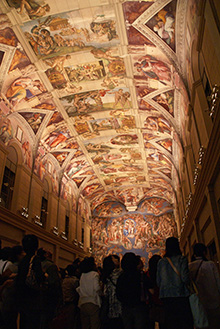 |
|
|
|
Michelangelo Buonarroti (1475-1564), Cappella Sistina (Sistine Chapel), The Vatican, Italy, approx. w2000 x d4000 x h1600 cm. Vault painting: The Creation of Adam and others, 1508-12, fresco. Wall painting: The Last Judgment, 1536-41, fresco. Photo by 663highland |
On display are 1,000-plus ancient and contemporary Western art masterpieces that are all reproductions. But not mere fakes: the works are actually printed on "ceramic boards" in their original size using a special technology developed by a porcelain maker in the Otsuka Group of companies. Waterproof and fireproof, these objects will retain their colors and appearance for approximately 2,000 years, the company estimates.
This calculation is based in part on Japanese Arita and Chinese porcelain ware found in a Dutch merchant ship that sank in the Indian Ocean several hundred years ago. The shapes and colors of the pieces were miraculously preserved while at the bottom of the sea. The porcelain was typically baked in kilns at 1,000 degrees centigrade. The Otsuka company baked its ceramic boards at 1,300 degrees centigrade, ensuring their survival for generations to come.
Left: Jacques-Louis David (1748-1825), Coronation of Napoleon I and Josephine, 1805-07, oil on canvas, 621 x 979 cm, Musee du Louvre. Right: Theodore Gericault (1791-1824), The Raft of the Medusa, 1818-19, oil on canvas, 491 x 716 cm, Musee du Louvre. Photo by Otsuka Museum of Art |
The museum was built in 1998 to commemorate the 75th anniversary of Otsuka Pharmaceutical Company, now one of the world's largest by sales. Located in Naruto Park, a well-known bird sanctuary that is part of Setonaikai National Park, the museum overlooks the breathtaking Seto Inland Sea. Nearby is where company founder Busaburo Otsuka built his first factory on a promontory between the Kii Channel and the Naruto Strait with its famous whirlpools.
It was "a handful of sand" from the strait that sparked the beginnings of the company's ceramic tile manufacturing business, based on their cutting-edge technology. A joint venture in 1973 with a ceramics company in the famed pottery town of Shigaraki near Kyoto was formed with the intention of advancing their production techniques. But it was the start of the oil crisis, and crude oil prices skyrocketed. Demand for ceramic tiles plummeted as building construction in Japan virtually stopped.
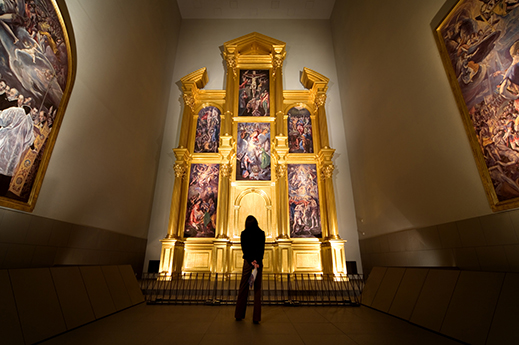 |
|
El Greco (1541-1614), Altarpiece (historical reconstruction), c.1600, 1258.2 x 773 cm.
Photo by Otsuka Museum of Art |
The company decided instead to venture into the world of art and "embellish ceramic boards with pictures." Reproducing the colors in works of art was no small challenge. But they were able to develop a remarkable 20,000 color variations, apparently a global first.
Despite their proven technology and enthusiastic support from then-president Masahito Otsuka (the founder's son) and the local Tokushima prefectural government, securing permission to copy Western artworks took many years. A team of six art historians was tasked with approaching museums and governments worldwide. But initially, their proposals were met with great skepticism.
The team cleared a major hurdle after gaining permission from the Italian and Vatican governments. The son of Picasso, descendants of Miro, and directors of overseas museums gave their approval after inspecting the Shigaraki factory and the museum construction site in Naruto. In all, 190 museums in 25 countries agreed to have their artworks reproduced.
Leonardo da Vinci (1452-1519), The Last Supper, 1495-98; tempera (wall painting); 420-910 cm; Santa Maria delle Grazie, Milano; views before and after restoration in original size.
Photo by Otsuka Museum of Art |
The Otsuka Museum of Art is the biggest exhibition space in Japan. With a total floor area of 29,412 square meters, it is 4 kilometers (2.5 miles) long and takes at least a full day to see it all. While the experience is worth the high entrance fee, it is easy to feel overwhelmed by the vast number of works hung closely together on the maze of walls throughout various floors.
For Japanese visitors, however, it can be a rare treat. Few large-scale exhibitions of famous works come to Japan because of the high insurance and transportation costs. The recent Louvre exhibition at the National Art Center, Tokyo, with about 70 pieces, was an exception.
Paintings at the Otsuka include Leonardo da Vinci's Mona Lisa and Last Supper (before and after restoration); The Last Judgment by Michelangelo; Picasso's Guernica (the original of which is never moved from the Museo Reina Sofia in Madrid, Spain); all of Rembrandt's self-portraits; and Van Gogh's Still Life: Vase with Five Sunflowers.
 |
|
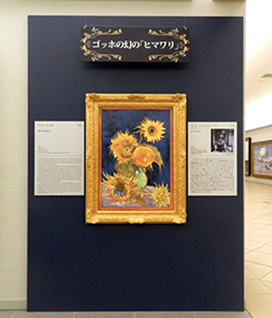 |
|
|
|
Leonardo da Vinci (1452-1519), Mona Lisa, 1503-06, oil on panel, 77 x 53 cm, Musee du Louvre, Paris. Since there is no risk of damage, visitors are invited to touch any of the artworks.
Photo by Lucy Birmingham |
|
Vincent van Gogh, Still Life: Vase with Five Sunflowers, 1888, oil on canvas, 98.0 x 69.0 cm. The original work was kept in Ashiya city, Hyogo Prefecture, but was destroyed in a World War II air raid in 1945.
Photo by Otsuka Museum of Art |
The museum also houses large-scale replicas of the Villa dei Misteri (Villa of the Mysteries) from Pompeii, Italy; the Cappella degli Scrovegni (Scrovegni Chapel, also known as the Arena Chapel) from Padua, Italy; a long-lost El Greco altarpiece with sections divided between Madrid and Bucharest; Monet's Water Lilies from the Musée de l'Orangerie in Paris, which is displayed out of doors; and a full-size interior reproduction of Michelangelo's Sistine Chapel from the Vatican.
 |
|
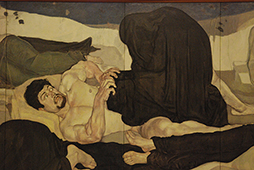 |
|
|
|
Sir John Everett Millais (1829-96), Ophelia, 1851-52, oil on canvas, 76.2 x 111.8 cm, Tate Gallery London. Photo by Lucy Birmingham |
|
Ferdinand Hodler (1853-1918), Night (partial), 1890, oil on canvas, 116 x 299 cm, Kunstmuseum Bern, Switzerland. Photo by Lucy Birmingham |
The museum's Sistine Chapel is also a venue for original Kabuki productions, performed there annually since 2009. The story themes are an exciting mix of Kabuki and Western-style drama. The show in February this year featured Homer's epic Greek poem The Odyssey with the hero Odysseus played by Japanese actor and Kabuki star Kataoka Ainosuke VI. His wife Penelope was played by stage actress Yamato Yuga, a former "top star" with the all-female Takarazuka Revue musical theater troupe.
One could hear the audience gasp in unison when Kataoka as Odysseus, dressed in leather pants, drove a motorcycle onto the stage upon his return home to Ithaca after his ten-year absence during the Trojan War. An unforgettable reproduction of an ancient tale, performed in an unforgettable reproduction of an iconic work of art. Only in Japan.
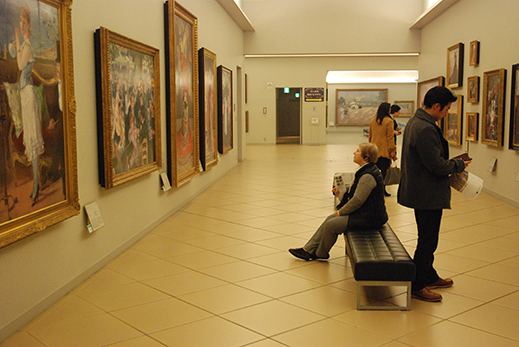 |
|
In the Exhibition Room of Modern Works. Photo by Lucy Birmingham
All images are by permission of the Otsuka Museum of Art.
|
 |
 |
Lucy Birmingham
Lucy Birmingham is a long-time, Tokyo-based journalist, scriptwriter, author, and former photojournalist. She currently serves as president of the Foreign Correspondents' Club of Japan. Her articles have appeared in many publications and websites, including TIME, The Wall Street Journal, Newsweek, Bloomberg News, and Architectural Digest. As an arts and culture writer her articles have appeared in publications including Artinfo.com, Artforum.com, and ARTnews. She is also a scriptwriter and narrator for NHK (Japan's public broadcaster) and has published several books including Strong in the Rain: Surviving Japan's Earthquake, Tsunami, and Fukushima Nuclear Disaster.
lucybirmingham.com |
|
 |
|
|
 |
|
 |
|